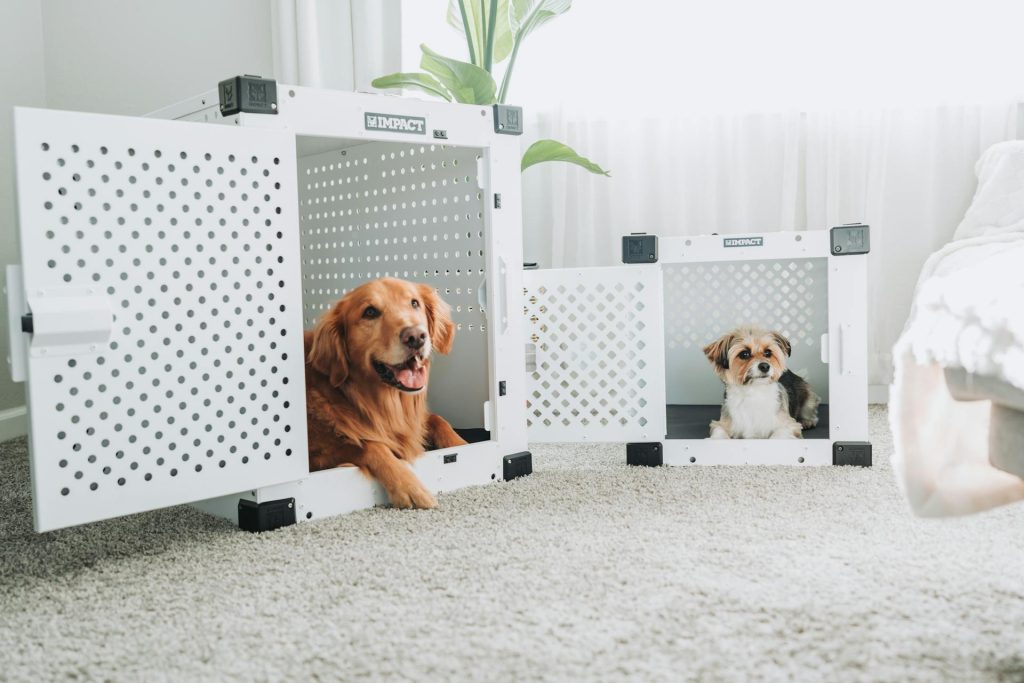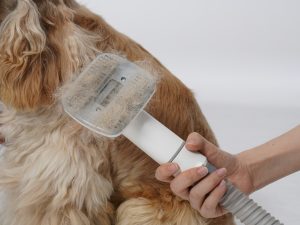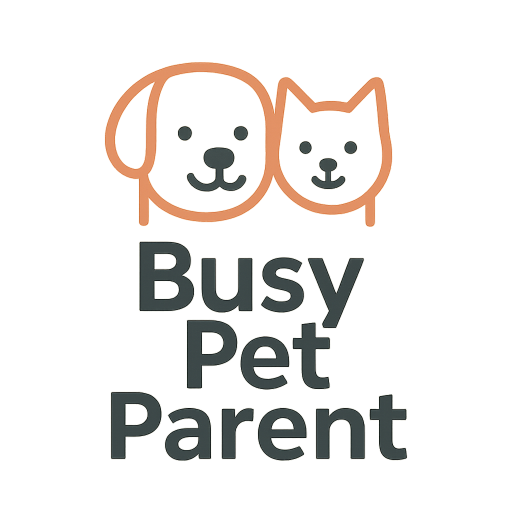
15 Effective Tips for Crate Training Apartment Dogs
Crate training apartment dogs comes with unique challenges—but it also offers incredible rewards. Whether you’re welcoming a new puppy or trying to help your adult dog feel more secure in a small space, a crate can become their favorite retreat (and your best sanity-saver). The key is making it feel safe, never stressful.
These 15 effective tips are designed specifically for apartment dwellers—where space is limited, neighbors are close, and routines really matter. Let’s help your pup love their crate and settle into apartment life with confidence.
1. Choose the Right Size Crate (Not Too Big)
In a small apartment, it’s tempting to buy a compact crate—but going too small or too large can backfire. Your dog should be able to stand, turn around, and lie down comfortably. A crate that’s too roomy may encourage accidents, while one that’s too cramped causes stress.
If you’re working with a growing puppy, look for a crate with an adjustable divider. This lets you resize the space as your dog matures—ideal for potty training and maximizing your limited square footage.
2. Make the Crate a Cozy, Low-Noise Zone
Apartment living often means shared walls, hallway traffic, and unpredictable noise from outside. These sounds can make your dog feel vulnerable in the crate—especially if it’s placed near a busy entry or exposed window. Your goal is to create a calming, insulated space where your dog feels protected, not overwhelmed.
Choose a low-traffic area of your apartment, ideally a corner away from windows and doors. Drape a breathable blanket over the crate (but never fully cover it), or use a crate cover made for sound-dampening. Add a soft crate pad, an old t-shirt that smells like you, and a safe chew toy. These small touches help your dog associate the crate with comfort, not confinement. If your dog struggles with anxiety from outside noise, this guide on helping your dog feel safe and calm in the crate is worth a read.
3. Avoid Using the Crate for Punishment
If your dog sees the crate as a “time-out zone,” they’ll quickly learn to fear it—not rest in it. In small apartments, where your dog can easily pick up on your tone, energy, and movements, using the crate as a punishment tool can backfire fast. It’s the difference between your pup retreating into their safe space... or resisting it entirely.
Never send your dog to their crate immediately after they’ve done something wrong, especially with a frustrated voice or rushed body language. Instead, use the crate proactively—when your dog is calm, sleepy, or chewing on a favorite toy. Reinforce it with treats or praise when they go in on their own. Over time, your dog will start choosing the crate because it feels secure, not because they were forced there after misbehaving.
4. Use a Routine to Build Comfort and Predictability
Dogs thrive on routine, and nowhere is that more important than in a confined apartment where daily structure helps reduce stress and reactivity. If your dog never knows when the crate will be used—or why—they’ll be far less likely to accept it willingly.
Begin crate training apartment dogs by anchoring crate time to predictable moments: after walks, mealtimes, or before naps. For example, if your dog tends to rest after breakfast, guide them into the crate calmly and reward them for settling. With consistency, your dog will begin to associate crate time with rest and positive downtime—not separation. A dependable crate routine also prevents the crate from feeling like a random event tied to your departure, which is key to easing anxiety in tight quarters.
5. Start With Short Sessions and Build Gradually
If your dog isn’t used to a crate, jumping straight into 30-minute sessions while you run errands is a recipe for barking, pacing, or accidents. Apartment dogs especially need a slow ramp-up to crate time, since they're rarely out of earshot or alone for long periods in small homes.
Begin with just 1–3 minutes while you remain nearby—reading, cooking, or working. Then gradually increase the time as your dog becomes more comfortable. Use calm praise and low-value treats for settling, but avoid dramatic goodbyes or high-energy entrances when crate time ends. Keep it boring. Boring builds confidence.
6. Use the Crate as a Natural Nap Zone During the Day
Crate training apartment dogs doesn’t just mean locking the door when you leave—it means shaping the crate into a space your dog actively chooses to rest in. And one of the easiest ways to build that connection is by aligning crate time with your dog’s natural nap patterns.
After a morning walk or mid-day play session, lead your dog to the crate when they’re already relaxed. Keep the door open and let them settle in on their own. Over time, the crate becomes associated with rest—not absence. In an apartment, where overstimulation from street sounds or neighbors can interrupt sleep, the crate serves as a peaceful escape. With consistency, it won’t just be where they nap—it’ll be where they choose to nap.
7. Try a Background Sound Machine or Calming Music
Living in an apartment means your dog hears everything: hallway footsteps, elevator dings, neighbor chatter, and delivery doors slamming shut. These sounds might seem like background noise to you—but for your dog, they’re unpredictable alerts that can interrupt crate time or cause unease.
A white noise machine or soft classical playlist can help mask these distractions. Play it consistently during crate sessions to build a soothing audio cue that signals “safe and quiet.” Some pet owners even use heartbeat-style sounds or nature tracks. You don’t need anything expensive—just a consistent sound buffer to help your dog stay relaxed and focused on resting, not reacting.
8. Feed Some of Your Dog’s Meals Inside the Crate
One of the easiest ways to help your dog see the crate as a positive space is to use it during mealtime. Feeding your dog their breakfast or dinner inside the crate—even with the door open—associates the space with nourishment, security, and comfort.
Start with placing the food bowl just inside the crate entrance. Gradually move it toward the back over a few days. If your dog is hesitant, try scattering a few kibble pieces leading up to the crate entrance or feeding from a stuffed Kong placed inside. In a small apartment where every meal counts as an enrichment opportunity, this simple strategy doubles as crate desensitization and mental stimulation—all without adding extra time to your routine.
9. Leave the Door Open When You’re Home
Crate training apartment dogs should never feel like forced isolation. One of the most underrated tips is to simply leave the crate door open during the day—especially when you’re home and your dog is free to choose where to relax.
Dogs are curious and naturally seek out cozy, den-like spots. If the crate is comfortable and not associated with punishment, your dog may start entering it voluntarily for naps or quiet time. Reinforce this behavior with calm praise, a soft “good crate,” or the occasional treat dropped inside when they use it on their own. This turns the crate into a lifestyle fixture—not just a tool for separation or sleeping. And in tight apartments, it gives your dog a dedicated retreat that doesn’t take up much space.
10. Don’t Rush Closing the Door
One of the biggest mistakes apartment dog owners make is closing the crate door too soon, too often. When crate training apartment dogs, early closures can trigger panic—especially in a compact environment where your dog feels every sound and vibration.
Instead, begin with the door open for several sessions. When you do close it, stay nearby, offer a treat or toy, and keep the time short—just 10–30 seconds at first. Gradually increase the duration only once your dog remains relaxed. In small spaces, dogs often associate closed crates with being left alone. Your goal is to break that connection by practicing closures while you’re home and calm, so it becomes a normal (and non-scary) experience.
11. Use Low-Value Chews to Occupy Time in the Crate
One of the best ways to help your dog stay calm in their crate is by providing something to do—especially if they’re still adjusting. Low-value chews (like a bully stick, rubber Kong with a dab of peanut butter, or a dental chew) keep their mouth busy and mind focused on something positive.
In an apartment, this approach is doubly helpful: it prevents boredom barking, encourages self-soothing, and gives your dog a consistent ritual to look forward to. Just avoid giving high-value or long-lasting chews if your dog is still anxious or protective of resources. The goal is calm engagement, not frantic excitement. You can rotate safe crate-only chews to keep things fresh and motivating without overstimulating your dog in a small space.
12. Keep Crate Time Short When You First Leave the Apartment
One of the most delicate parts of crate training apartment dogs is the moment you actually leave. Many dogs experience separation anxiety in the first 5–15 minutes after departure—especially when confined. And in an apartment, where barking echoes and walls are thin, that stress can quickly become disruptive.
During the early weeks of training, avoid leaving your dog crated and alone for long periods. Start with 2–5 minute departures—take out the trash, check the mail, or walk down the block. Use a low-drama goodbye and a predictable return. Gradually build up to longer outings. If your dog struggles, revisit your routine or consult a professional. Consistency, calmness, and patience are the keys to building true independence—even in a tiny apartment.
13. Use Crate Time After Play, Not Before
Timing is everything when crate training apartment dogs—and trying to crate an under-stimulated, full-energy pup is a recipe for resistance. In small spaces, where your dog can’t zoom around to release energy on their own, crate time works best after a satisfying physical or mental activity.
Before scheduled crate time (especially if you’re leaving the apartment), try a quick 10-minute walk, a hallway fetch session, or a mentally stimulating food puzzle. Once your dog’s body and brain are satisfied, they’ll be more likely to settle calmly in the crate instead of whining, pawing, or pacing. Think of crate time as the cooldown, not the warm-up.
14. Reinforce Quiet Behavior, Not Just Crate Entry
Many crate training guides focus on getting your dog into the crate—but the real skill is teaching them how to relax once inside. In an apartment, where noise complaints are a real concern, reinforcing calm behavior is just as important as the initial crate command.
Don’t just toss a treat when your dog enters the crate—reward moments when they lie down quietly, sigh, or settle on their own. Walk by and drop a kibble without saying a word. This teaches your dog that calm, quiet crate time is what earns rewards—not barking or trying to follow you around the room. Quiet behavior should feel safe, expected, and even enjoyable. Over time, this builds a lasting habit of calm independence.
15. Use the Crate Even When You’re Home (Not Just When You Leave)
If your dog only goes into the crate right before you leave, they’ll quickly associate it with abandonment—and that’s the last thing you want. For apartment dogs who hear your every movement and rarely experience real distance, that negative connection can grow fast.
To prevent this, incorporate crate time during your normal routine—even when you’re home. Let your dog relax in the crate while you cook, read, or fold laundry. Keep it casual and reward them for staying inside calmly. This helps your dog learn that crate time isn’t just linked to being alone or separated—it’s a normal, safe part of daily life. In a small apartment, that kind of crate neutrality is the foundation for long-term comfort.
Final Thoughts
Crate training apartment dogs isn’t about confinement—it’s about creating a consistent, calm, and secure environment in a small space. With the right techniques, your dog’s crate becomes a comfort zone rather than a punishment. When combined with potty training structure, barking prevention habits, and enriching indoor games, the crate becomes a healthy part of your dog’s apartment routine.
Don’t forget to consider room-by-room pet safety when choosing a crate location, and address sound sensitivity with calming practices like those recommended by Fear Free Happy Homes. If you're unsure about crate timing or behavior concerns, your vet can help guide you using preventive care guidelines tailored to your dog’s age and needs.
Frequently Asked Questions
How long does crate training take in an apartment?
It varies by dog, but most pups adjust within 2–4 weeks when crate time is introduced slowly and positively. Consistency and routine are especially important in small living spaces.
Should I crate my dog every time I leave the apartment?
Not necessarily. If your dog is fully crate-trained and relaxed when left alone, crating during departures is helpful. But mixing in free time with safe confinement can also work once trust is established.
What if my dog barks in the crate when I’m home?
Ignore barking if it’s attention-seeking and reward moments of quiet. Reinforce crate use during downtime—not just departures—to prevent frustration when you're nearby but unavailable.
Can I crate train an older dog in an apartment?
Absolutely. Adult and senior dogs can benefit from crate routines—especially for managing anxiety or creating structure in new environments. You may just need extra patience and slower desensitization.
What’s the best crate size for an apartment dog?
The crate should be large enough for your dog to stand, turn, and lie down—no more, no less. Too much space can lead to accidents, while too little causes discomfort. Use a divider if your puppy is still growing.

Join the Busy Pet Parent Newsletter!
Get easy routines, time-saving tips, and the latest gear reviews—delivered straight to your inbox.
Perfect for busy pet owners, apartment dwellers, and anyone who wants a happy, healthy companion (without the stress).
Exclusive guides & checklists
Product recommendations & deals
No spam—unsubscribe anytime!




